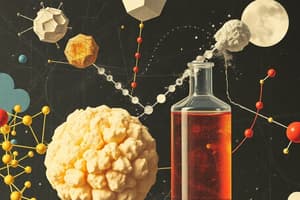Podcast
Questions and Answers
Why do solids have strong intermolecular forces?
Why do solids have strong intermolecular forces?
- Due to weak bonds between particles
- Because the particles are tightly packed together (correct)
- Because the particles are far apart
- Due to the high kinetic energy of particles
Why do liquids have intermediate boiling and melting points?
Why do liquids have intermediate boiling and melting points?
- Due to the close proximity of particles (correct)
- Due to weak intermolecular forces
- Because they have very high kinetic energy
- Because the particles are freely moving
Why do gases have much lower boiling and melting points compared to solids and liquids?
Why do gases have much lower boiling and melting points compared to solids and liquids?
- Due to the weak intermolecular forces in gases (correct)
- Because gases are tightly packed together
- Because gases have high kinetic energy
- Due to strong intermolecular forces
What is the fundamental unit of matter composed of two or more atoms bound together by chemical bonds?
What is the fundamental unit of matter composed of two or more atoms bound together by chemical bonds?
What determines how fast and freely molecules move within a substance?
What determines how fast and freely molecules move within a substance?
Why do gases allow molecules to move freely with only occasional collisions between them?
Why do gases allow molecules to move freely with only occasional collisions between them?
What was the key discovery made by James Chadwick that led to him being awarded the Nobel Prize?
What was the key discovery made by James Chadwick that led to him being awarded the Nobel Prize?
What is the relationship between the atomic number (Z) and the number of protons and electrons in a neutral atom?
What is the relationship between the atomic number (Z) and the number of protons and electrons in a neutral atom?
What is the relationship between the mass number (A) and the number of protons and neutrons in an atom?
What is the relationship between the mass number (A) and the number of protons and neutrons in an atom?
What was the key discovery made by Ernest Rutherford in his gold foil experiment?
What was the key discovery made by Ernest Rutherford in his gold foil experiment?
What is the charge of a titanium atom with an atomic number of 22 and a mass number of 48?
What is the charge of a titanium atom with an atomic number of 22 and a mass number of 48?
What is the relationship between protons, neutrons, and nucleons in an atom?
What is the relationship between protons, neutrons, and nucleons in an atom?
What is the essential component of water?
What is the essential component of water?
What percentage of the Earth's surface is covered by water?
What percentage of the Earth's surface is covered by water?
What is the continuous movement of water in the biosphere called?
What is the continuous movement of water in the biosphere called?
What happens when energy increases during a phase change?
What happens when energy increases during a phase change?
What is the process of turning water vapor into liquid water called?
What is the process of turning water vapor into liquid water called?
Which of the following is an example of precipitation?
Which of the following is an example of precipitation?
Which factor affects the ionization energy of an element?
Which factor affects the ionization energy of an element?
How does larger atomic size affect reactivity?
How does larger atomic size affect reactivity?
Why do elements with lower ionization energies exhibit higher reactivity?
Why do elements with lower ionization energies exhibit higher reactivity?
What is the relationship between electronegativity and reactivity?
What is the relationship between electronegativity and reactivity?
How does the distance of valence electrons from the nucleus affect reactivity?
How does the distance of valence electrons from the nucleus affect reactivity?
What characterizes elements with lower ionization energies regarding electron removal?
What characterizes elements with lower ionization energies regarding electron removal?
What is the Greek origin of the word 'atom'?
What is the Greek origin of the word 'atom'?
Which type of ion has more protons than electrons?
Which type of ion has more protons than electrons?
What is the main difference between isotopes and ions?
What is the main difference between isotopes and ions?
What principle dictates that electrons occupy orbitals with lower energies before higher energy orbitals?
What principle dictates that electrons occupy orbitals with lower energies before higher energy orbitals?
Where is the high probability of finding electrons in an atom?
Where is the high probability of finding electrons in an atom?
In atomic electron configuration notation, what does '1s² 2s² 2p²' represent for Carbon?
In atomic electron configuration notation, what does '1s² 2s² 2p²' represent for Carbon?
Flashcards are hidden until you start studying




